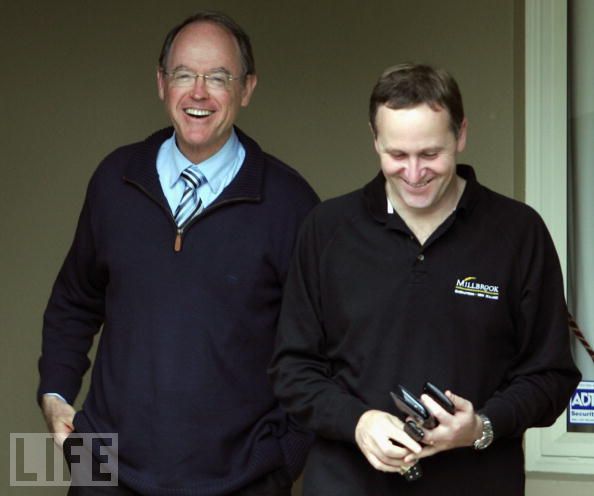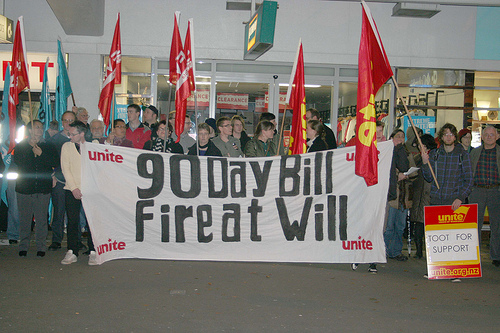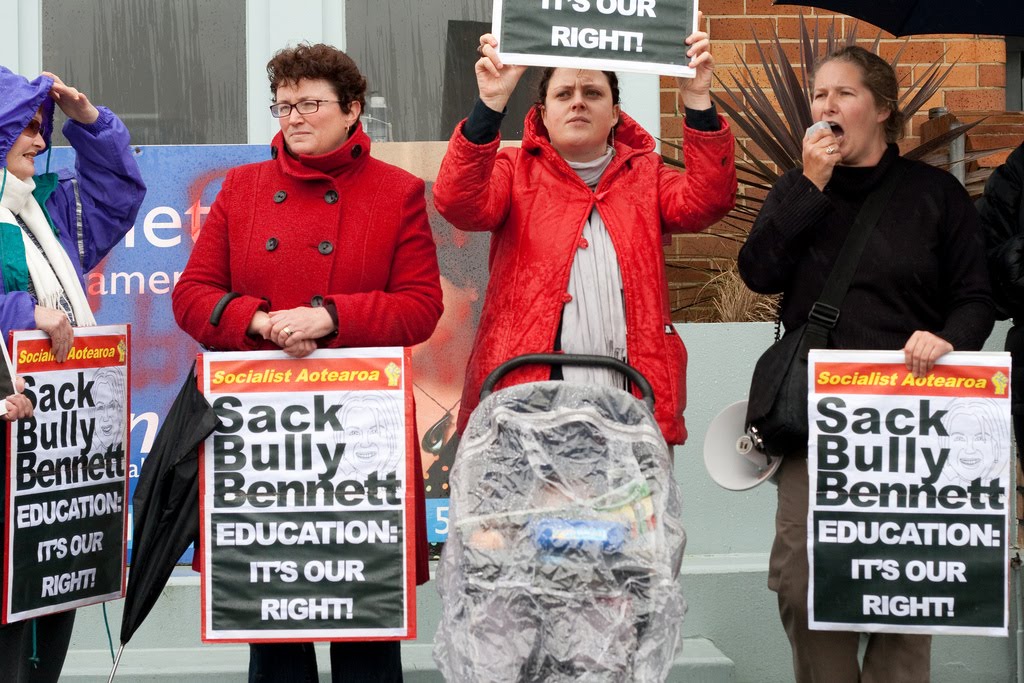This article by Jared Phillips and Josh Glue is concerned with characterising the type of National Party that is in government today. Originally published in the October issue of The Spark.
 In a 2007 Agenda interview with then-new National Party leader John Key, Lisa Owen asked him about the difference in leadership style between himself and his predecessor, now-Act leader, Don Brash. Key’s reply was:
In a 2007 Agenda interview with then-new National Party leader John Key, Lisa Owen asked him about the difference in leadership style between himself and his predecessor, now-Act leader, Don Brash. Key’s reply was:
Well I think leadership’s always a very personal thing, it’s the way that you approach the issues, the image that you put off, the things that maybe you want to discuss, I mean fundamentally Don and I share the same view which is that we think New Zealand under-performs and we think that the future can be much brighter with a National government with the policies that we want to invoke, so I don’t think our fundamental aim was different, we may choose to focus on – in the very short term some different issues and you’ve possibly seen that in my approach since I’ve taken over as the leader.
This is an interesting reply as it draws out one of the key issues surrounding the nature of the National Party. Is National fundamentally a neo-liberal party, playing a strong public relations (PR) game, with the Act party playing a role as its most neo-liberal flank? Or is National a centrist party eager not to alienate its apparent support from echelons of the working class?
National’s post-election appearance
At the time of its 2008 election there was some anticipation from parts of the left – including members of the Workers Party at the time – that the National Party was going to refrain from carrying out serious attacks on the working class because of the centrist nature of its campaign and the level of broad cross-class support which it enjoyed in the lead-up to the election. Soon after the election the new government put parliament under urgency and fired the first shot against working people by introducing 90-day probationary employment to take effect in small workplaces. This was a serious attack, in that it was so obviously the thin end of the wedge for further anti-worker laws.
After the election, and in response to the recession which resulted from the global financial crisis, John Key called national and regional economic summits which offered a place of dialogue for the Council of Trade Unions, other union leaders, and other non-business entities. On one hand this could be portrayed as political centrism but on the other hand the holding of such economic summits is not a new tactic for governments embarking on attacking the working class. The Labour Party used exactly this tactic in the 1980s when it carried out the first wave of the neo-liberal assault on working people. Further, such summits are used to put any potential opposition groups under the spotlight and on best (conservative) behavior rather than to share any power with them.
Industrial relations
 To manage the financial crisis and recession, the government has worked to further erode the power of unions and drive up the rate of exploitation at work. It has brought in the 90-Day “fire at will” law, allowing employers to sack new employees in the first 3 months of employment without reason or right to unfair dismissal claims. This law is particularly onerous for the already vulnerable, namely immigrants, women, younger and older people and Maori, as these groups were already disadvantaged in the labour market, being more concentrated in less secure employment in harder-to-organise sectors. Other changes have made it more difficult for unions to enter worksites. Even in cases whereby justified dismissal has been accepted reinstatement has been downgraded from being the primary remedy. The Holidays Act has been changed so that individual workers’ fourth week of holiday can be sold, which increases productivity to the detriment of workers quality of life. The Holidays Act has also been changed so that the employer may require a medical certificate for only one day of sickness. The cumulative impact of all this policy is that productivity is driven up for the employers and it is far easier for the entire capitalist class to maintain and increase discipline over the workforce.
To manage the financial crisis and recession, the government has worked to further erode the power of unions and drive up the rate of exploitation at work. It has brought in the 90-Day “fire at will” law, allowing employers to sack new employees in the first 3 months of employment without reason or right to unfair dismissal claims. This law is particularly onerous for the already vulnerable, namely immigrants, women, younger and older people and Maori, as these groups were already disadvantaged in the labour market, being more concentrated in less secure employment in harder-to-organise sectors. Other changes have made it more difficult for unions to enter worksites. Even in cases whereby justified dismissal has been accepted reinstatement has been downgraded from being the primary remedy. The Holidays Act has been changed so that individual workers’ fourth week of holiday can be sold, which increases productivity to the detriment of workers quality of life. The Holidays Act has also been changed so that the employer may require a medical certificate for only one day of sickness. The cumulative impact of all this policy is that productivity is driven up for the employers and it is far easier for the entire capitalist class to maintain and increase discipline over the workforce.
In the public sector, understaffed ministries are struggling to cover increasing workloads with new-hirings far below requirements and government spending on the non-productive economy has fallen further below demand for public services. The 2011 Budget only allows enough money for public service to tick over, not taking into account cost increases or the need for more staff to deal with higher unemployment and underemployment and their effects.
Taxation
One of the key messages of the left in the lead-up to the last election was to abolish GST, reduce it, or limit the items to which it applied. Typically the far-left called for the abolition of GST and the centrist or social democratic left called for a reduction or limitation. Important for the purposes of this article is the fact that a GST reduction of some kind was called for universally by all workers organisations and a significant number of progressive and community organisations. In 2010 the government legislated a 2.5% increase in GST (to 15%) despite GST-reduction being a core demand amongst above-mentioned organisations. GST-reduction, including abolition, was called for because the cost of living for ordinary working people – and especially the poor – needed to be relieved. Massive increases in reliance on food grants and food banks amid minimum wage rises lower than inflation are one sign that many people are struggling to make ends meet. The government, far from taking a centrist position, acted in direct contradiction to this most basic demand.
In fact, the government rearranged taxation in such a way that working people carry even more of the tax burden by shouldering a GST increase in order to help pay for tax cuts which disproportionately advantaged (if tax cuts are considered an advantage) the already rich. For example, the 12% of tax payers in the $70,000 + per annum bracket received a saving of $1625.51 million, whilst the 31% of taxpayers in the $20,000 – $50,000 per annum bracket received a saving of $987.21 million. In other words the wealthiest 12% saved nearly twice as much from the reduction in tax outlay than did those 31% who earn between $20,000 and 50,000 per year.
Here the nature of the current National Party comes into stark contrast with its middle-of-the-road rhetoric. These tax cuts for the wealthy and super-rich were sold to the average working person as a tax cut for them, despite the fact that even the modest gains the new tax regime affords those earning less than $70,000 will be eaten up by the rising cost of living and the GST hike which only rubs salt in the wound, punishing the working class, who spend a higher proportion of their income on goods and services than do the wealthy.
Other cuts
 The prospect of cuts to unemployment benefits is also on horizon, again veiled in talk of ‘fixing’ the benefit system and ‘helping people back to work’. In fact tightening of criteria for receipt of benefits has already taken place. Cuts to Early Childhood Education will see the centres with the most qualified staff forced to make layoffs, and the overall quality of early childhood education decrease at the same time as prices for service rise. Government subsidies for adult education programmes have been cut, as has funding to community law centres and some domestic violence agencies.
The prospect of cuts to unemployment benefits is also on horizon, again veiled in talk of ‘fixing’ the benefit system and ‘helping people back to work’. In fact tightening of criteria for receipt of benefits has already taken place. Cuts to Early Childhood Education will see the centres with the most qualified staff forced to make layoffs, and the overall quality of early childhood education decrease at the same time as prices for service rise. Government subsidies for adult education programmes have been cut, as has funding to community law centres and some domestic violence agencies.
The changes to industrial law and the tax regime are sufficient to show that the government is not following a centrist path or a path determined by any minor interest group. It is following a straight-up-and-down continuation of the assault on working people that has been carried out by capitalist governments for the last 30 years.
National’s PR machine
Recent polls place support for National at around 56%, while Labour’s support is tanking at around 30%, sometimes lower. The public relations machinery is very effective, especially so given the low levels of class consciousness and class fight-back (for example, in the year to December 2010 work stoppages were at their lowest number in two decades) which are required to repel and break the government’s current popularity. Included amongst National’s PR arsenal are issues such as its eventual anti-mining position with regard to the Coromandel, its accommodation with the Maori Party, and its apparent preference for public-private partnerships over privatisation.
However, in matters like this, the appearances are deceptive. The Coromandel may have been saved or delayed from being mined, due to public pressure, but oil exploration has started off the East Cape. National’s relationship with the Maori party doesn’t reveal a willingness to progress Maori issues or class issues for the majority of Maori, but rather reflects a relationship with some upper-echelons of Maoridom, and a large number of Maori have broken from that process. Public-private partnerships allow the government to make claim that they are not privatising, but that it is exactly what they are doing at the pace available to them and to the extent that such options are available.
Gaining an advantage from the spotlight during large public tragedy events (Pyke River Mine and the Christchurch earthquakes), and taking advantage of planned public events (such as the Rugby World Cup), competently in both scenarios, has also helped along Key and National’s populism.
Conclusion
National could not be led – and its particular form of continued reform on behalf of the ruling class could not be carried out – by a Brash-styled party of the type that would publically argue for a decline in actual wages, would publically argue against Maori rights, etc. However, National has been able to leverage off Act to advance its agenda while maintaining some public distance from its more extreme neo-liberal aspects. The placement of Rodney Hyde as Minister of Local Government for the creation of the Auckland Supercity, VSM, and the role of the Act party in sharpening-up the anti-worker laws evidence this. As we come into a likely second-term of National-led government, it is worthwhile for any leftist who views this government as a centrist one to reexamine their view.

Just another WordPress site